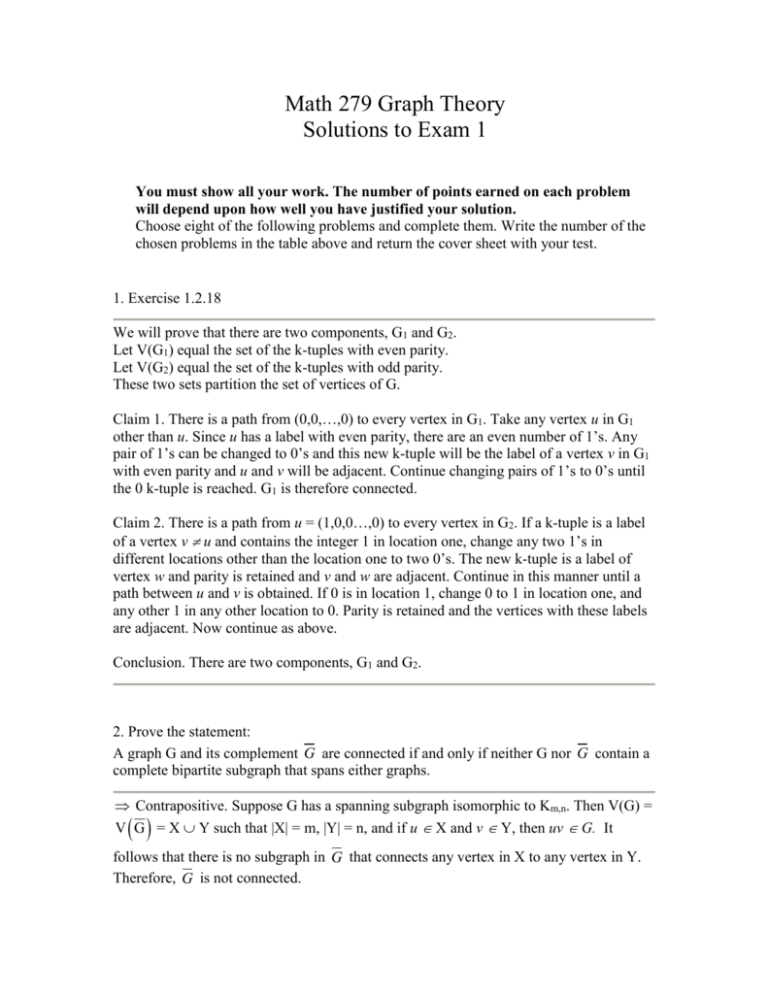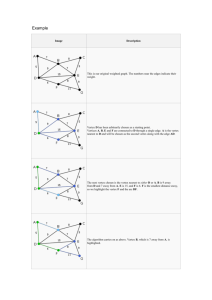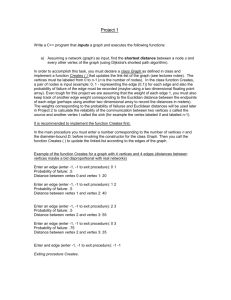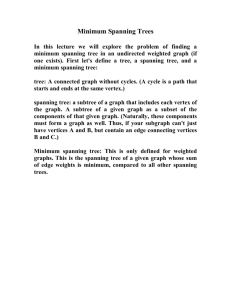Midterm 1
advertisement

Math 279 Graph Theory Solutions to Exam 1 You must show all your work. The number of points earned on each problem will depend upon how well you have justified your solution. Choose eight of the following problems and complete them. Write the number of the chosen problems in the table above and return the cover sheet with your test. 1. Exercise 1.2.18 We will prove that there are two components, G1 and G2. Let V(G1) equal the set of the k-tuples with even parity. Let V(G2) equal the set of the k-tuples with odd parity. These two sets partition the set of vertices of G. Claim 1. There is a path from (0,0,…,0) to every vertex in G1. Take any vertex u in G1 other than u. Since u has a label with even parity, there are an even number of 1’s. Any pair of 1’s can be changed to 0’s and this new k-tuple will be the label of a vertex v in G1 with even parity and u and v will be adjacent. Continue changing pairs of 1’s to 0’s until the 0 k-tuple is reached. G1 is therefore connected. Claim 2. There is a path from u = (1,0,0…,0) to every vertex in G2. If a k-tuple is a label of a vertex v u and contains the integer 1 in location one, change any two 1’s in different locations other than the location one to two 0’s. The new k-tuple is a label of vertex w and parity is retained and v and w are adjacent. Continue in this manner until a path between u and v is obtained. If 0 is in location 1, change 0 to 1 in location one, and any other 1 in any other location to 0. Parity is retained and the vertices with these labels are adjacent. Now continue as above. Conclusion. There are two components, G1 and G2. 2. Prove the statement: A graph G and its complement G are connected if and only if neither G nor G contain a complete bipartite subgraph that spans either graphs. Contrapositive. Suppose G has a spanning subgraph isomorphic to Km,n. Then V(G) = V G = X Y such that |X| = m, |Y| = n, and if u X and v Y, then uv G. It follows that there is no subgraph in G that connects any vertex in X to any vertex in Y. Therefore, G is not connected. Contrapositive. Suppose G is not connected. Then V(G) = X Y where no vertex of X is adjacent to any vertex in Y, and if |X| = m and |Y| = n, G has a spanning subgraph Km,n. 3. Exercise 1.2.42 Proof by contradiction. The statement is true for K2. Consider a vertex v of maximum degree. Assume G K2 and deg(v)≥ 2. Let us assume that there is a vertex a such that v is not adjacent to a, that is v is not adjacent to all vertices in G. Consider the vertices in the neighborhood of v. There is some vertex u N(v) that is adjacent to some vertex w N(v). This follows since G is connected and there must be a path from v to a. It may be that a = w. The degree v ≥ 2, and since d(u) ≤ d(v), there is a vertex x in the neighborhood of v to which u is not adjacent. We then have a path of length 4. Call the path x,v,u,w where x and u N(v). Since we cannot have an induced subgraph P4, w must be adjacent to x or v. But, we would then have w N(v) or an induced subgraph C4. This contradicts the hypothesis, and the statement hold as true. 4. Draw the graph D5 as on page 61. From this graph find a de Bruijn cycle of length 32. 01111100110001001010111011010000 5. Exercise 2.1.22 Summing the degrees we have 2 3 ... k n k 1 2( n 1) 2n 2 (1 2 3 ... k ) k n 2 1 2 3...( k 1) n 2 (k 1)k n2 2 k 2 k 2n 4 n k2 k 4 2 6. Use Corollary 2.2.4 to count the number of labeled trees with n = 6 vertices. To receive full credit, the counting of the trees in every isomorphism class is required. Since 2n – 2 = 2(6) – 2 = 10, we need a partition of 10 into 6 integers, with at least two integers equal to 1. They are as follows: a. 5,1,1,1,1,1 b. 4,2,1,1,1,1 c. 3,3,1,1,1,1 d. 3,2,2,1,1,1 e. 2,2,2,2,1,1 (6 2)! 1 graph with the labeled degree sequence. a. By Corollary 2.2.4, there are 4! 6 There are 6 such sequences resulting in 6 trees. 1 4! 4 graph with the labeled degree sequence. There are b. By Corollary 2.2.4, there are 3! 6 5 30 such sequences resulting in 120 trees. 1 1 4! 6 graph with the labeled degree sequence. There c. By Corollary 2.2.4, there are 2!2! 6 are 15 such sequences resulting in 90 trees. 2 4! 12 graph with the labeled degree sequence. There d. By Corollary 2.2.4, there are 2! 6 5 are 60 such sequences resulting in 720 trees. 1 2 4! 24 graph with the labeled degree sequence. There e. By Corollary 2.2.4, there are 1! 6 are 15 such sequences resulting in 360 trees. 4 That is a total of 6 + 120 + 90 + 720 + 360 = 1296 labeled trees with 6 vertices 7. Find all automorphisms of the graph below. Any automorphisms will fix the vertices a and d. The vertices c and d can only be sent to themselves as they are of degree 3 and no other vertices are of degree 3. The vertices g and h can only be sent to themselves since they are both of degree two and both adjacent to a vertex of degree 6. No other vertex has these characterizations. The vertices f and g can only be sent to themselves since they are the only vertices of degree 1. There will be 2 x 2 x 2 = 8 automorphisms. (a )(b)(c)( d )(e)( f )( g )( h) (a )(bc)( d )(e)( f )( g )( h) (a )(b)(c)( d )(e)( f )( gh) (a )(b)(c)( d )(ef )( g )( h) (a )(bc)( d )(ef )( g )( h) (a )(bc)( d )(e)( f )( gh) (a )(b)(c)( d )(ef )( gh) (a )(bc)( d )(ef )( gh) 8. a. Prove that a self-complementary graph has diameter equal to 2 or 3. b.Find an example of a self-complementary graph of diameter 2 and one of diameter 3. a. By exercise 2.1.15, if G has diameter at least 4 that its complement has diameter at most 2. Since a self-complementary graph is isomorphic to its complement, the diameter must be less than four. The only graphs with diameter 1 are the complete graphs which are not selfcomplementary. b. P4 and C5 9. Exercise 2.2.16 Name the vertex of degree n u and name the vertices along the path v1, v2, …, vn in that order. Say a spanning tree contains the edge u,v1, but not v1,v2. Then there are an-1 spanning trees. Say a spanning tree contains the edge v1,v2, but not u,v1. Then there are an-1 spanning trees. We now consider the number of spanning trees containing both of the edges u,v1 and v1,v2. We have one that includes the entire path v1, v2, …, vn. If, along the path, we omit the edge v2,v3, we have an-2 spanning trees, since u,v2 cannot be in any such spanning tree. In fact, if vi,vi+1 is not is a spanning tree then no edge u,vi can be an edge of a spanning tree. So, if along the path, we omit the edge v3,v4, we have an-3 spanning trees. Continuing in the way, we omit the edge vn-1,vn, we have a1 spanning trees. n 1 This gives us a total of an an 1 1 ai . i 1 n 1 Prove for n>2, if an an 1 1 ai then an 3an1 an2 . i 1 By induction on n. Base case. When n = 3, we are given that a3 a2 1 a1 a2 or a3 3 1 1 3 8 a3 3(a2 ) a1 3(3) 1 8 and the statement holds. Hypothetical assumption. Assume that the statement hold for all k < n. n 1 n2 We are given an an 1 1 ai 2an 1 1 ai . i 1 i 1 n2 n2 i 1 i 1 From above, we have an 1 an 2 1 ai ai an 1 an 2 1 . Using the hypothetical assumption we substitute this last summation into the above and n2 we have an 2an 1 1 ai 2an 1 1 (an 1 an 2 1) 3an 1 an 2 and the statement i 1 holds. 10. A tournament T is transitive if uv T and vw T implies uw T. Prove a tournament is transitive if and only if it is a acyclic. If n = 1 or 2, the statement holds since any such tournament is acyclic and vacuously transitive. Suppose n ≥ 3. There is an underlying 3-cycle. We prove the contradiction. Suppose T is transitive and T has a cycle (u1,u2, …, uk) of length k. Since T is transitive, there is an edge u1,u3. Since we have u1,u3 and u3,u4, we have u1,u4. Continuing this way we can say that we have u1,un-1. But, in this case, since we have un-1,un on the cycle, by transitivity we have u1,un. But, un,u1 is an edge on the given cycle. A contradiction. By contradiction. We prove the statement: If T is acyclic then T is transitive. Suppose there are no cycles and T is not transitive. That is, for every underlying 3-cycle (u,v,w), if if uv T and vw T, then uw T. That is, T is transitive. 1 (v ) , n vV (G ) Determine (G ) for each of the following. a. Kn b. Pn c. Cn d. Km,n e. the wheel Wn – the graph with n vertices along a cycle and a center “hub” or center vertex that is adjacent to every vertex on the cycle 11. The eccentric mean (G ) a. (v) 1 for every vertex ( Kn ) 1 b. n even: n2n n-1 n 2 2 n-1 The sum of the eccentricities is 2 i=2 2 2 n i= 2 2 2 3n 2n 3n 2n 3n 2 2 ( Pn ) 4 2 4 n:odd n 1 n 1 n-1 n-1 n 2 2 + n-1 n-1 The sum of the eccentricities is 2 i+ =2 2 2 n+1 2 2 i= 2 2 2 2 3n 4n 1 n-1 3n 2n 1 3n 2n 1 2 ( Pn ) + 4 2 4n 2 n n 2 n n c. (v) for every vertex (Cn ) n 2 2 d. We consider the cases where m,n ≥ 1. If m = n = 1 then (G ) =1. If, n = 1, then (v) 2 for every vertex except "hub" and (hub) 1 ( K1, m ) 2m 1 m 1 Otherwise, 2n 2 n (v) 2 for every vertex on the rim and (hub) 1 (v) 2 for every vertex ( K m, n ) e. (Wn ) (2n+1)/n 2n 1 n 1









